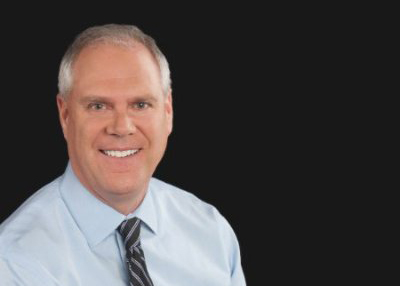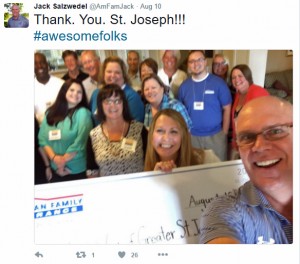I’ve been interviewing CEOs about social media for a few months now and what shines out is their genuine desire to lead from the front. It’s a feature they all have in common.
This week my interviewee is someone I’ve been wanting to feature for some time – none other than Jack Salzwedel, CEO of American Family Insurance – otherwise known on Twitter as @AmFamJack. Even among that rare breed of CEOs that use Twitter, Jack stands out. Voted the ‘most engaged Fortune 500 CEO on Twitter’ by Fortune Magazine, he is the epitome of the ‘social CEO’.
To start with, can I ask why you decided to sign up for Twitter? What were your primary motives?
Several years ago I spoke with one of our communications interns about social media. I wasn’t familiar with Twitter at the time but wanted to learn as it made the most sense for me. This was one of those opportunities for leaders to practice reverse mentoring – to give employees the opportunity to teach you some new things that will ultimately make you a better leader. At the time, social media was quickly becoming a medium our employees, customers and other leaders were embracing and using to share ideas and talk to each other every day. It’s only grown since then. I was ready to jump in and, in retrospect, I’m glad I reached out for help.
Some people still say that using social media isn’t a CEO’s job. What’s your response?
I totally disagree. Social media is the best way to engage with your workforce – especially one spread out across the country or globe. It’s valuable for those employees you see more regularly, too – as a way to stay connected and make face-to-face engagement even more valuable. Social media also supports a CEO’s critical role in being the face, and in many instances the voice, of the brand. Leaders – especially CEOs – are missing a huge opportunity by skipping this important and vital role.
“Social media supports a CEO’s critical role in being the face, and in many instances the voice, of the brand”
What value to do personally get from using social media – and Twitter especially?
I enjoy staying on top of what’s happening in the world. Twitter is especially good at providing this quicker pulse of news and information. Whether it’s Twitter Moments or Snapchat Stories or Facebook’s trending topics, you can streamline your news and information consumption through social media. Twitter saves me time because I don’t have to go to numerous locations to find news or relevant information. It’s on Twitter, and it’s usually happening there first.
“Twitter saves me time because I don’t have to go to numerous locations to find news or relevant information”
I also like the ability to connect with new people and make new friends and connections through social media. It’s one of the more fun parts of my day when I can comment on an employee’s favorite new book or movie that’s just come out. This is how you can build deeper connections with people.
Do you think leadership style affects how successful (or not) CEOs are on social media?
Yes, your leadership style is definitely a factor in how well you’ll embrace and be successful with social media. More transparent and approachable CEOs and leaders will gravitate to social media. They’ll also be more open to this way of communicating and gathering knowledge. But it is something you can learn. I’m a big proponent of constant learning, and social media is something you should understand and use if you’re a leader today.
“Social media is something you should understand and use if you’re a leader today”
You talk about and engage with AmFam’s employees a lot on Twitter – giving shout-outs and congratulations. I imagine that helps engender a loyal, ‘family’ atmosphere in the company.
I believe it does, but also it enables critical ‘skip-level’ relationships that can help bring info to CEOs that wouldn’t necessarily be able to skip upwards. Not everything leaders learn about employees translates to traditional forms of communications either. Social media helps fill in crucial gaps and provides me with additional and valuable insight into who I’m leading, what they’re thinking and how they’re feeling about things. It’s also a direct line of communication for them to me, which is valuable for both of us, and for the health of our organization. At American Family, this fits really well with our evolving culture that aspires to be more open and collaborative. We even have a hashtag that we use to describe this collective spirit – #OneAmFam.
“Social media fills in crucial gaps and provides me with additional and valuable insight into who I’m leading, what they’re thinking and how they’re feeling about things”
I’m interested in your ‘lean’ philosophy, whereby you empower your managers to empower employees – thus making the entire workforce more engaged and energized in their work. Does social media play any part in this?
Social media creates the environment where everyone can have a voice in things. The real key is that ‘lean’ per se should not be thought of, or focused on, reducing FTE or expenses for the benefit of the organization – it’s about the value chain and benefits for the customer. What the lean process does do, however, is allow those involved to evaluate and make changes – that’s the empowerment aspect.
“From the CEO to first line management to processors, we are all aligned. And social communication helps with that alignment”
Social communication – team huddles supported by blogs, podcasts and Twitter, etc – play an important role in the change process because we truly are all in this together for the benefit of our customer. From the CEO to first line management to processors, we are all aligned. And social communication helps with that alignment.
You have a very interesting blog. Not only do you post articles on leadership and business (which are great, by the way) – you also produce podcasts with interesting individuals from the world of sport. What do you get out of doing the blog and the podcasts?
Blogging and podcasting give me the ability to get beyond 140 characters and delve into topics of interest at a deeper level. This is especially true with leadership, something I’m passionate about. As for podcasts, they are gaining in popularity and, for me, they provide a faster-paced, more authentic way to talk with people. And yes, I’ve been fortunate to have some very interesting guests and topics, which I’ve shared both with our employees and with my social media followers. Podcasts also provide American Family Insurance with a strategic communications tool. We use podcasts – some of which only our employees and agents can hear – to break down complex issues and topics. They are excellent for supplementing some of the more traditional communication tools and have generated some great discussion and engagement within the company.
How do you find LinkedIn as a publishing platform? How does it compare to your blog in terms of readership and interaction?
LinkedIn’s publishing platform is another way to reach a pretty captive audience. My early take on it was positive, and it continues to provide a better engagement and sharing platform than traditional blogs. It helps get my ideas in front of new people, and opens yet another door for engagement with our workforce and with others.
Do you try to measure the outcome of your social media activity in any way? Is interaction even something that should be measured?
Being on social media is table stakes for today’s leaders, so I’d say start there. Being active and engaged is the most important. Sure, you can measure the impact of what you do, the stuff you share. You can also get bogged down in vanity metrics like followers and retweets and likes. You shouldn’t, though. Focus on being present, consistent and regular. Listen more than you talk, and you’ll find the value, the return on your time investment.
“Focus on being present, consistent and regular. Listen more than you talk and you’ll find the value, the return on your time investment”
If you could give advice to other CEOs who are reluctant to embrace Twitter, what would it be?
Decide that you’d like to do this for real, get some help and dive in. What do I mean by help? You’ll want to start by talking about and engaging with folks interested in certain topics. But you likely don’t have the time to be on top of everything related to that topic. So get some help finding and developing relevant content that you can share on social media. Find your voice and get out there.
More broadly, how do you think the role of leaders has changed/will have to keep changing as the world becomes more digitally connected?
It’s not enough to use one or two communication tools to reach others. You need all of them. Social media can be your most effective – and efficient – tool for reaching a wide and varied audience. Embrace the changes that are happening. If you’re uncomfortable, get comfortable with this rapid pace of change. You’ll find that a lot of the digital transformation of our world mirrors that of our business world. There’s opportunity to learn as well as contribute.
“If you’re uncomfortable, get comfortable with the rapid pace of change”
As the CEO of an insurance company, how do you see wider ‘digital disruption’ and the IoT impacting on your industry?
American Family values innovation — not only within our own walls, but inside companies where we see potential for investments or partnerships. We live in an exponential era, a concept we’ve stressed with our leadership group at American Family. Things change fast, and it’s not just enough to stay on top of trends. We need to find ways to set them. As my friend and colleague Peter Gunder likes to remind me, “Either disrupt yourself or be disrupted by someone else.”
“Either disrupt yourself or be disrupted by someone else”
This is how we approach adjacent spaces like IoT – where we can find complementary opportunities that benefit our customers in a rapidly-changing world.
________________________
That, folks, is Social Leadership 101, courtesy of @AmFamJack. In just twelve questions he has basically written the rules on how to be a social CEO. But’s it’s not just applicable to CEOs – anyone in a leadership role can learn from Jack and apply his insights to do their job better. After all, in 2016, leadership isn’t about command and control – it’s about empowerment, openness, accountability – and leading from the front.

